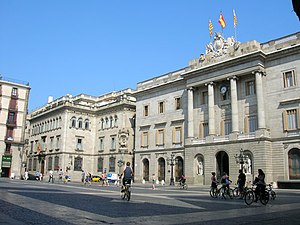Gothic Quarter, Barcelona
This article needs additional citations for verification. (March 2016) |



The Gothic Quarter (Catalan: Barri Gòtic, IPA: [ˈbari ˈɣɔtik], Spanish: Barrio Gótico) is the centre of the old city of Barcelona. It stretches from La Rambla to Via Laietana, and from the Mediterranean seafront to Ronda de Sant Pere. It is a part of Ciutat Vella district.
The quarter was built primarily in the late 19th and early 20th century, though several buildings date from medieval times. Remains of the squared Roman Wall can be seen around Tapineria and Sots-Tinent Navarro to the north, Avinguda de la Catedral and Plaça Nova to the west and Carrer de la Palla to the south. El Call, the medieval Jewish quarter, is located within this area too.
The Barri Gòtic retains a labyrinthine street plan, with many small streets opening out into squares. Most of the quarter is closed to regular traffic although open to service vehicles and taxis.
Landmarks
- Cathedral of Santa Eulàlia
- Basilica of La Mercè
- Church of Santa Maria del Pi
- Church of Sant Miquel
- Plaça Sant Jaume, including Casa de la Ciutat (city hall) and Palau de la Generalitat de Catalunya (presidential palace).
- Plaça Reial
- Plaça del Rei, including Barcelona City History Museum (MUHBA) and Palau Reial Major
- Plaça de Sant Felip Neri
- Portal de l'Àngel
- Remains of the Temple of Augustus in Barcelona
- Els Quatre Gats
Controversy over authenticity of the Gothic Quarter
In 2011, a controversy emerged over the authenticity of numerous Gothic Quarter buildings due to the publication of a dissertation entitled "The Gothic Quarter of Barcelona: Planning the Past and Brand Image" by Agustín Cócola. According to the author, during the neoclassical period of the city's history, the downtown quarter was completely transformed from a sombre neighborhood to a tourist attraction through a massive restoration project. The transformation of the neighborhood was mostly completed in time for the 1929 International Exhibition, which then took on great significance in displaying both the city and Catalunya in a positive light to the world's media. Further restoration of existing buildings and the creation of brand new Neo-gothic works continued as late as the 1960s. The seminal work of Agustín Cócola and other contributors from the Department of Architectural Composition, Universitat Politècnica de Catalunya in recognizing the invention of the “Barri Gòtic” has played an important role in our understanding of the complex process Barcelona underwent in an attempt to promote a sense of national identity of Catalan Art and Culture.
Among the principal buildings with neo-gothic additions or rebuilt or are included:
- Barcelona Cathedral’s façade: constructed between 1882 and 1913 by Josep Oriol Mestres and August Font i Carreras with a profusion of Gothic style elements.
- Hiking Center of Catalonia’s building (Paradís Street): work by Lluís Domènech i Montaner carried out in 1922 on a building of uncertain origins to which he added Coronella windows, battlements, and merlons.
- The Flamboyant-style bridge that crosses Bisbe street: newly constructed 1928 by Joan Rubió.
- Casa Padellàs (Padellas's House): currently Barcelona City History Museum headquarters, moved from Mercaders street to Plaça del Rei in 1931. Its inner parts are rebuilt.
- Aguilar Palace: present-day Museu Picasso (Montcada street), restored by Adolf Florensa in 1959, who added galleries with arches and Coronella windows.
- Pignatelli Palace: present-day Royal Artistic Circle of Barcelona, restored in 1970 including the addition of various Gothic windows retrieved from municipal warehouses.
Crime
The Gothic Quarter is one of two extremely popular pickpocketing hotspots in Barcelona, the other being La Rambla. It is a major problem in both areas of the city. Tourists are advised to be wary when in these areas.
